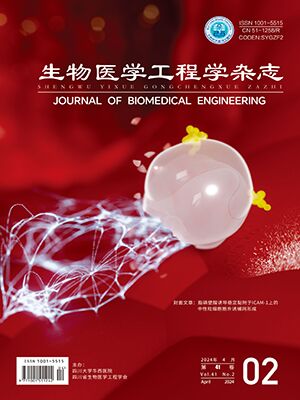| 1. |
李江涛, 郑敏军, 曹辉. 经颅磁刺激技术的研究进展. 高电压技术, 2016, 42(4): 1168-1178.
|
| 2. |
董国亚, 汤志华, 韩婷彦, 等. 各向异性真实头模型下深部脑刺激电场分布. 电工技术学报, 2015, 30(S2): 37-41.
|
| 3. |
Amassian V E, Stewart M, Quirk G J, et al. Physiological basis of motor effects of a transient stimulus to cerebral cortex. Neurosurgery, 1987, 20(1): 74-93.
|
| 4. |
Fujiki M, Kobayashi H, Abe T, et al. Repetitive transcranial magnetic stimulation for protection gainst delayed neuronal death induced by transient ischemia. J Neurosurg, 2003, 99(6): 1063-1069.
|
| 5. |
Ji R R, Schlaepfer T E, Aizenman C D, et al. Repetitive transcranial magnetic stimulation activates specific regions in rat brain. Proc Natl Acad Sci U S A, 1998, 95(26): 15635-15640.
|
| 6. |
Sun Peng, Wang Furong, Wang Li, et al. Increase in cortical pyramidal cell excitability accompanies depression-like behavior in mice: a transcranial magnetic stimulation study. J Neurosci, 2011, 31(45): 16464-16472.
|
| 7. |
Bentwich J, Dobronevsky E, Aichenbaum S, et al. Beneficial effect of repetitive transcranial magnetic stimulation combined with cognitive training for the treatment of Alzheimer’s disease: a proof of concept study. J Neural Transm (Vienna), 2011, 118(3): 463-471.
|
| 8. |
Liu Xu, Ramirez S, Pang P T, et al. Optogenetic simulation of a hippocampal engram activates fear memory recall. Nature, 2012, 484(7394): 381-385.
|
| 9. |
Wu Y, Xu W W, Liu X W. Effect of repetitive transcranial magnetic stimulation with different frequency on cognitive function in patients with Alzheimer’s disease. J Pract Med, 2015, 31(10): 1624-1627.
|
| 10. |
程建, 吴文. 高频重复经颅磁刺激治疗阿尔茨海默症效果的Meta分析. 实用医学杂志, 2016, 32(15): 2539-2543.
|
| 11. |
Tan Tao, Xie Jiacun, Tong Zhiqian, et al. Repetitive transcranial magnetic stimulation increases excitability of hippocampal CA1 pyramidal neurons. Brain Res, 2013, 1520(3): 23-35.
|
| 12. |
Zhu Haijun, Xu Guizhi, Fu Lindi, et al. The effects of repetitive transcranial magnetic stimulation on the cognition and neuronal excitability of mice. Electromagn Biol Med, 2020, 39(1): 9-19.
|
| 13. |
Wang Hualong, Xian Xiaohui, Wang Yanyong, et al. Chronic high-frequency repetitive transcranial magnetic stimulation improves age-related cognitive impairment in parallel with alterations in neuronal excitability and the voltage-dependent Ca2+ current in female mice. Neurobiol Learn Mem, 2015, 118: 1-7.
|
| 14. |
Chen R, Classen J, Gerloff C, et al. Depression of motor cortex excitability by low frequency transcranial magnetic stimulation. Neurology, 1997, 48(5): 1398-1403.
|
| 15. |
Cotelli M, Calabria M, Manenti R, et al. Improved language performance in Alzheimer disease following brain stimulation. Neurol Neurosurg Psychiatry, 2011, 82(7): 794-797.
|
| 16. |
Zhang Chengliang, Lu Rulan, Wang Linxiao, et al. Restraint devices for repetitive transcranial magnetic stimulation in mice and rats. Brain Behav, 2019, 9(6): 7.
|
| 17. |
Banerjee J, Sorrell M E, Celnik P A, et al. Immediate effects of repetitive magnetic stimulation on single cortical pyramidal neurons. PLoS ONE, 2017, 12(1): 14.
|
| 18. |
Yu Haibo, Zou Beiyan, Wang Xiaoliang, et al. Effect of tyrphostin AG879 on Kv4. 2 and Kv4.3 potassium channels. Br J Pharmacol, 2015, 172(13): 3370-3382.
|
| 19. |
Angelova P, Muller W. Oxidative modulation of the transient potassium current IA by intracellular arachidonic acid in rat CA1 pyramidal neurons. Eur J Neurosci, 2006, 23(9): 2375-2384.
|
| 20. |
Müller W, Bittner K. Differential oxidative modulation of voltage-dependent K+ currents in rat hippocampal neurons. J Neurophysiol, 2002, 87(6): 2990-2995.
|
| 21. |
Coetzee W A, Amarillo Y, Chiu J, et al. Molecular diversity of K+ channels. Ann NY Acad Sci, 1999, 868: 233-285.
|
| 22. |
杨佳佳. 三聚氰胺对大鼠海马CA1区神经元兴奋性的影响及其机制的研究. 天津: 南开大学, 2011.
|
| 23. |
Ekberg J, Craik D J, Adams D J. Conotoxin modulation of voltage-gated sodium channels. Int J Biochem Cell Biol, 2008, 40(11): 2363-2368.
|
| 24. |
Nelson M T, Quayle J M. Physiological roles and properties of potassium channels in arterial smooth muscle. Am J Physiol, 1995, 268(4): C799-C822.
|
| 25. |
王华龙. 重复经颅磁刺激改善老化相关的认知功能损伤的电生理机制及潜在代谢产物的变化. 石家庄: 河北医科大学, 2014.
|
| 26. |
Martin-Belmonte A, Aguado C, Alfaro-Ruiz R, et al. Density of GABAB receptors is reduced in granule cells of the hippocampus in a mouse model of Alzheimer’s disease. Int J Mol Sci, 2020, 21(7): 18.
|
| 27. |
朱海军, 丁冲, 徐桂芝. 膜片钳技术及其在神经科学研究中的应用. 生命科学研究杂志, 2017, 21(3): 251-256.
|
| 28. |
陈小佳, 谭涛, 刘迢迢, 等. 大鼠海马CA1区锥体神经元I_A和I_K在出生后早期的变化. 生理学报, 2013, 65(2): 193-200.
|
| 29. |
Ahmed Z, Wieraszko A. Pulsed magnetic stimulation modifies amplitude of action potentials in vitro via ionic channels-dependent mechanism. Bioelectromagnetics, 2015, 36(5): 386-397.
|
| 30. |
Aydin-Abidin S, Trippe J, Funke K, et al. High- and low-frequency repetitive transcranial magnetic stimulation differentially activates c-Fos and zif268 protein expression in the rat brain. Exp Brain Res, 2008, 188(2): 249-261.
|




